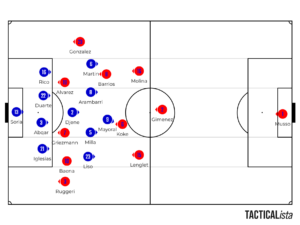When intensity falters: How Atlético won a battle against Getafe (0-1)
Diego Simeone and José Bordalas went to battle, as the two managers had a hard fought game between their two intense teams. And as expected, it was little details that decided the game.
Tactical analysis and match report by Sebastián Parreño
On 23 November 2025, at the Coliseum Alfonso Pérez, Getafe CF welcomed Atlético de Madrid in a match that pitched two very similar tactical identities against each other, at least in the public perspective. Two defensive-minded coaches, known for their intense style and tough low-block defenses, faced off in a game where most would predict a classic goalless draw. That prediction nearly came true. But the way the game was played probably wasn’t what many thought it would be.
The Setups
Getafe deployed a 4-1-4-1 out-of-possession set-up, with Djené as the sole pivot behind a midfield quartet of Arambarri and Milla centrally, and wingers Martín on the left and Liso on the right. Meanwhile Atleti operated from a 3-1-4-2 type of structure. In the opening phases, Atlético attempted to dictate the tempo from the back, but Getafe’s defensive architecture frustrated them. Whenever a full-back from Atlético received the ball, Getafe’s wide midfielders sprang into action: Martín and Liso would advance aggressively, seeking to disrupt the first progression lines. Concurrently, Arambarri would step out from his midfield line when his trigger condition was met (often when José María Giménez received the ball), leaving Djené to step up into the void and temporarily transform Getafe’s shape into a 4-4-2.

Atlético’s in possession set up against Getafe’s 4-1-4-1.
The logic behind this pattern was simple: deny Atlético clean build-up by forcing hurried passes or long balls, cut off the pivot zone (Koke) from influence, and entice transitional mistakes. For much of the first half this game plan held up effectively. Atlético had more of the ball, but penetration was scarce. The full-backs and wing-backs found little joy due to Getafe’s disciplined compactness and the aggressive triggers upon receiving.
Atlético, by contrast, began with a 5-4-1 out of possession formation, with Marcos Llorente tucking into a hybrid role of right wing-back/attacking midfielder, and Nahuel Molina integrating into the build-up from the right. Koke assumed the solitary pivot role in possession. The meeting thus set up a classic structural battle: Getafe seeking to impress their mid-block discipline and trigger moments of aggression; Atlético looking to break through with width, support, and positional tweaks. Llorente’s early injury in the first half then forced the team to change multiple positions. Griezmann came on and played inside, below Álvarez, acting almost as a second striker. Nico González moved from left flank to right to cover Llorente’s role.

Getafe’s 4-3-3 in possession against Atlético’s 5-4-1.
In possession, Atlético’s build-up centred around front-foot width movements: Ruggeri would push high on the left, nearly aligning with the attackers in order to stretch the pitch, while Molina tucked inside or moved high from the right to form a back-three with the central defenders when on the front foot. The aim was to force Getafe’s mid-block wider, open lanes between lines, and allow Koke to operate behind the front trio. But Getafe stuck to their plan. Their mid-block remained flat and compact, the transitions were quick: whenever possession was won, Liso surged into the space behind the full-back line, seeking fast counter-attacks. Although these counters did not result in goals, they provided a clear threat and prevented Atlético from fully relaxing into possession.
Second half
The second half began under the same shape, but the intensity of Getafe’s pressing gradually dropped. The wide midfielders jumped less frequently, Arambarri’s bursts became less sharp, and the mid-block lost some of its cohesion. These subtle changes were consequential. Atlético observed and adapted. As Getafe’s press waned, Atlético gained more freedom. The own goal that decided the game arrived when Djené was temporarily off the pitch receiving treatment, leaving Getafe with ten men in a critical transitional moment. A cross into the box was redirected into the net, the sort of moment that sums up the tactical fine margins of high-level football: a momentary structural lapse meets an opponent ready to exploit it. Following the goal, Atlético controlled possession, endured Getafe’s attempts at response and managed the closing stages with composure. Getafe’s desired high-intensity phase did not return, their counters were less frequent, and the match ended 0-1.
From the tactical vantage point, the key lessons are clear. Getafe’s mid-block and initial pressing scheme were well-executed and frustrated Atlético for long stretches. But such a plan demands sustained intensity and sharpness; once that drops, the structural underpinning begins to crack. Atlético’s win shows the value of patience, positional flexibility and tactical adaptation: even when denied clear domination early on, structural changes (the substitution of Griezmann, shifting González, exploitation of width) may turn the tide. For Getafe the game will be remembered as one in which their plan worked in defence but expired in intensity, while for Atlético it is another example of how adaptive tactics and opportunism can yield victory in tight encounters.
Takeaways
This match was a classic example of a tight tactical battle. Getafe implemented a clear game plan: mid-block, trigger on full-back passes, win the second ball, and counter. For large stretches, they succeeded in stifling Atlético. However, Atlético’s structural flexibility, game-management and exploitation of a momentary lapse turned the tide. The winning goal was narrow—an own goal—but the underlying tactical foundations from Atlético were present: width, overloads, patience, and opportunism.
For Getafe the disappointment will be that the game was within reach; the intensity drop and that one play and moment where they went down to 10 men ended up costing them the game. For Atlético it underlines that with the right tactical tweaks and substitute impact, they can grind out results even when not at their attacking best.
Match plots will be added as soon as possible



Comments